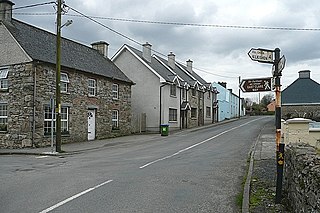
Tuamgraney is a village in eastern County Clare in the west of Ireland and a civil parish by the same name. Situated a kilometre from the River Graney which flows into Lough Derg, it is an ancient settlement, noted for St Cronán's Church, said to be the oldest church in constant use in Ireland

Feakle is a village in County Clare, Ireland, in the Roman Catholic parish of the same name. The village is in a townland and civil parish of the same name.

O'Callaghan's Mills, also O'Callaghansmills, is a village in County Clare, Ireland, and a Catholic parish by the same name. It takes its name from the O'Callaghan family who were large landowners in the area and a corn and grist mill built by John Coonan on the lands of Cornelius O'Callaghan in 1772.

Kilmaley is a village in County Clare, Ireland, 8 kilometres (5 mi) west of Ennis. The name "Kilmaley" came from the Irish language "Cill Mhaile" which translates to Church of (Saint) Maley.

Kilkishen is a village in southeast County Clare, Ireland. The village is 8 kilometres (5 mi) east of Quin and 14 kilometres (8.7 mi) north of Shannon.

Clonlara, officially Cloonlara, is a village in County Clare, Ireland, and a Roman Catholic parish of the same name.

Tulla Lower is a barony in County Clare, Ireland. This ancient geographical division of land is in turn divided into eight civil parishes.
Templemaley is a civil parish in County Clare, Ireland. It contains the village of Barefield and part of the town of Ennis.

Kilseily is a civil parish in County Clare, Ireland. The main settlement is the village of Broadford.
Kiltenanlea or Kiltonanlea is a civil parish in County Clare, Ireland.

Killanena is a townland and formerly a district electoral division (DED) in County Clare, Ireland, in the Catholic parish of Killanena.

Kilchreest is a civil parish of County Clare, Ireland. It contains the village of Ballynacally and is part of the Roman Catholic parish of Ballynacally (Clondegad), which includes the civil parish of Clondagad to the north.
Kilnoe is a civil parish in County Clare, Ireland. It is a rural area, part of the Roman Catholic parish of Bodyke.
Moynoe is a civil parish in County Clare, Ireland. It is part of the Roman Catholic parish of Scarriff and Moynoe.

Doonbeg (Killard) (Irish: Cill Ard) is a civil parish on the Atlantic coast of County Clare in Ireland. It is also an ecclesiastical parish in the Roman Catholic Diocese of Killaloe. The largest population centre in the parish is the village of Doonbeg.

Kilmurry-Negaul is a civil parish and a village in County Clare, Ireland.
Clonrush or Clonmulsk is a civil parish in the barony of Leitrim, now in County Clare, Ireland. The largest settlement in the parish is Whitegate.

Killuran is a civil parish in County Clare, Ireland. It contains the village of O'Callaghans Mills. It is united with the civil parish of Kilkishen in the Catholic parish of O'Callaghans Mills.

Kilkee, formerly Kilfearagh, is a parish in the Roman Catholic Diocese of Killaloe located in County Clare, Ireland. It lies on the Loop Head peninsula between the Atlantic Ocean and the Shannon Estuary. The main settlement is the resort town of Kilkee. The parish contains many ruins, some dating to the early days of Christianity in Ireland.
O'Callaghan's Mills, also named O’Callaghan’s Mills & Kilkishen, is a parish in County Clare, Ireland, and part of the Ceantar na Lochanna grouping of parishes within the Roman Catholic Diocese of Killaloe. The parish is an amalgamation of the medieval parishes of Clonlea and Killuran plus some townlands taken over from other parishes.















